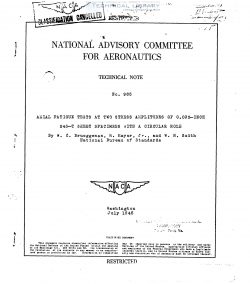naca-tn-983
- Version
- 152 Downloads
- 485.15 KB File Size
- 1 File Count
- December 1, 2016 Create Date
- December 1, 2016 Last Updated
National Advisory Committee for Aeronautics, Technical Notes - Axial Fatigue Tests at Two Stress Amplitudes of 0.032'' 24S-T Sheet Specimens with a Circular Hole

Most of the available fatigue data for aircraft metals
have been obtained with constant stress amplitude. Fatigue
loads in aircraft are usually variable in character. Obvi— .
ously there are periods in which the load amplitude is al—
ternately high and low in groups of cycles or even in the
same cycle. There are so many possible variations that it
would be impracticable to make enough tests to determine
the fatigue strength under every conceivable loading condi—
tion. However, there is some hope of determining certain
principles of the fatigue behavior of metals under variable
stress amplitude. A beginning has been made for ferrous
metals in determining damage lines (reference 1) and the
effects of understressing and overstressing on the endur-
ance limit.
Perhaps the most important problem is to determine
the number of cycles to failure under the condition of
loading shown in figure 1, in which n; cycles with a
stress amplitude S; are followed by n; cycles with a
stress amplitude S; .... and so forth. until failure
occurs after nn cycles at stress amplitude S . The
problem is to determine the total number of cycles to fail-
ure.
The following simple formula has been used by L. H. Donnell.
William H. Bleakney. and others (no published reference
could be found) for determining N from the usual S-N
curve of the material.
Equation (2) may be criticized on the ground that it
makes no allowances for the beneficial effect of stresses
below the fatigue limit (reference 1), since all terms are
positive and therefore decrease the fatigue life. Langer
(reference 2) tried to overcome this difficulty by replacing
the S—N curve by the damage line and by adding negative
terms to the sum. However. the procedure introduces a
number of additional unknowns and it would be difficult to
apply to materials such as aluminum alloys which do not
have a definite fatigue limit.
Both Biezeno's and Langer'e formulas gives an answar
‘for the total number of cycles to failure which depends
only on the distribution of cycles n1. n3. ..., :1n and
not on their sequence. Thus, the same number of cycles to
failure would be obtained according to the formulas with
stress amplitudes increasing with time as with stress
amplitudes decreasing with time, provided the number of
cycles for each stress amplitude is the same.
In view of the practical importance of the problem,
the National Advisory Committee for Aeronautics has author—
ized a research project at the National Bureau of Standards
to determine the effect on fatigue life of varying the stress
amplitude and to compare the observed effect with that given
by simple formulas such as equation (2).
| File | Action |
|---|---|
| naca-tn-983 Axial Fatigue Tests at Two Stress Amplitudes of 0.032'' 24S-T Sheet Specimens with a Circular Hole.pdf | Download |

Comment On This Post